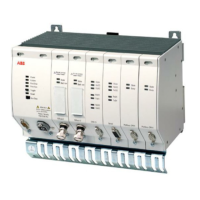6 Functional Description of the Ethernet Modules
6-3
6.1.2 Installing an Ethernet module
When plugging an Ethernet module into the AC 800F for the first time, note that there
may be electrostatic discharge from the module which may cause malfunctions of the
AC 800F electronics.
To avoid damage resulting from ESD, proceed as described below when in-
stalling or replacing a module. Note that this procedure is mandatory:
1. Make sure that the AC 800F is switched off.
If required, switch off the AC 800F.
2. Remove either the already installed board to be replaced or the cap (dummy
panel) from the appropriate slot.
3. Establish a good electrical contact between a passive part of the housing and the
special ESD protection bag in which the module has been delivered to you.
4. Take the Ethernet module out of the ESD protection bag. Do not touch the board
components. Only touch the module front panel.
5. Carefully insert the Ethernet module into the appropriate slot E1 or E2. Touch the
AC 800F housing either while inserting the module into the slot or at least directly
prior to inserting it in order to provide for discharge.
There are contacts on the upper and lower edge of the board which act as high-
resistance bridges towards the housing. This eliminates residual charges that may
still exist and avoids electromagnetic interference.
6. Hand-tighten the screws on the module front panel top and bottom. Only then it
can be guaranteed that the specified EMC requirements values are met.
7. Lock the slide-lock to cover
the upper locking screw. Use
an appropriate tool to slide the
lock to the left hand side until
the screw head is completely
covered and the Lock inscrip-
tion is visible.
Fig. 6-1 Locking the module slide lock
Only when the module has been plugged in and locked properly, it will be switched
on and identified.
8. Make the Ethernet cabling.
9. Switch on the AC 800F.

